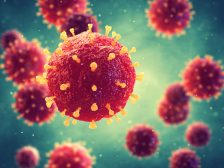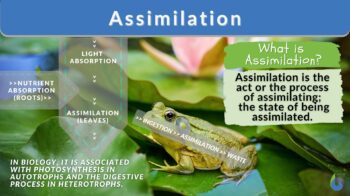
Assimilation
n., plural: assimilations
[əˌsɪməˈleɪʃən]
Definition:
The act or process of assimilating; the state of being assimilated. In biology, it is associated with the photosynthesis in autotrophs and the digestive process in heterotrophs.
Table of Contents
Assimilation Definition
What is assimilation? Assimilation in biology is defined as the process in which living organisms integrate the nutrients from various external resources into their body and utilizes them to satisfy the energy demands required to stay alive. In another meaning, assimilation refers to the absorption of vitamins, minerals, and other chemicals from food within the intestinal tract. Furthermore, assimilating can also pertain to the breaking of complex molecules available in the food into simpler particles, and then the movement of those modest units in those destinations in the living body where they are required such as active cells is often cited as assimilation. The process of photosynthesis, nitrogen fixation, conversion of magnesium supplements, and the formulation of biological tissues and fluids via the adsorption of nutrients into the human body after digestion in the intestine are some of the practical applications of biological assimilation. Moreover, the growth, the renewal of the organisms, the structural developments, their reproduction, and the restoration of energy reserves in the body are supported by assimilation. It is often cited in thermodynamics that the human bodies are an open system which means that it can only exist and survive with the uninterrupted input of energies from the external resources supplied and hence, that supports the significance of assimilation in biology.
Assimilation is the conversion of nutriment into a usable form (e.g. liquid or solid) that is incorporated into the tissues and organs following the processes of digestion or to the chemical alteration of substances in the bloodstream by the liver or cellular secretions. In plants, it refers to the processes of photosynthesis and the absorption of raw materials by which plants derive their nutrition. Examples of assimilation are photosynthesis, nitrogen fixation, and the absorption of nutrients after digestion into the living tissue.
Impact of Assimilation on Living Organisms
Solar irradiation is the primary source of energy for all living creatures in the universe. The living organisms found on Earth, based on their use of various forms of nutrition to fulfill energy demands (Figure 1) are divided into two types:
- Autotrophic Organisms
- Heterotopic Organisms
The organisms that are capable of producing their food via light, water, carbon dioxide, and other chemicals are known as autotrophic organisms. The whole process in which the inorganic compounds in the form of various oxides of carbon are converted into organic compounds such as carbohydrates, amino acids, proteins, and other useful components is called carbon fixation also referred to as carbon assimilation. The autotrophic organisms are further classified into photoautotrophs and litho autotrophs based on the utilization of sunlight and inorganic oxidation processes respectively. On the other side, heterotopic organisms are those kinds of creatures that are not capable of producing their own food and for energy supplies, they solely rely on obtaining energy from external resources by assimilating the organic matter present in the food they eat. Thus, during assimilation, the complex proteins and carbohydrates are converted into glucose and amino acids. Therefore, in respiration, glucose is employed while the amino acids are acquired in the building of new proteins. It is very important to understand that the process of dissimilation (the renewal of components parts due to destruction) and assimilation take part continually. Thus, it can be perceived from the above discussion that assimilation is a very vital phenomenon for the movement of digested food particles into various cells of the body where energy is required.
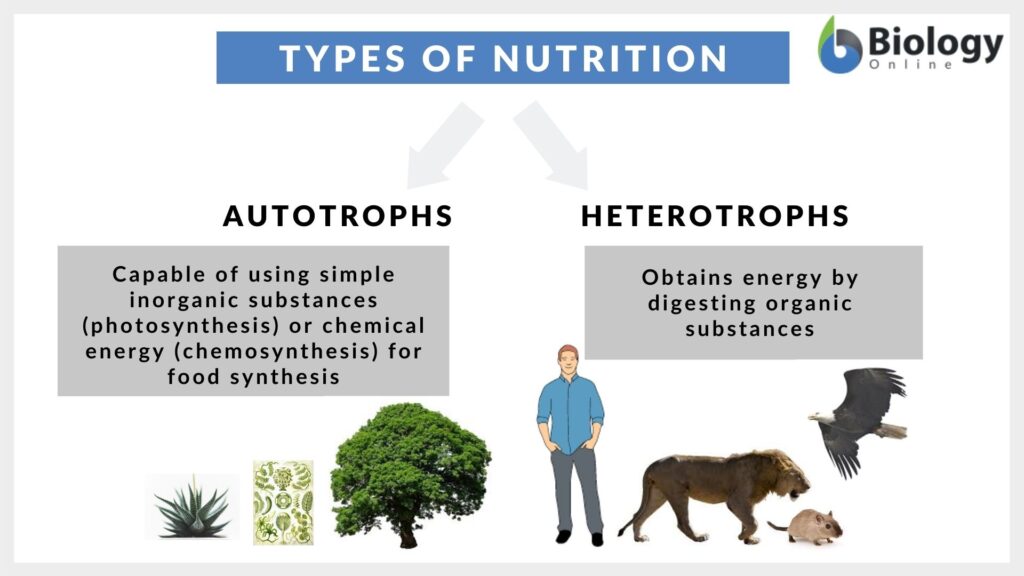
Examples of Assimilation
What does assimilation mean in terms of process? The process of assimilation occurs in nearly all forms of living organisms in the world. See below to learn some of the examples of assimilation in various groups of organisms.
Plant assimilation
What is an example of assimilation in plants? Nitrogen is the basic ingredient for the survival and growth of plants. The nitrogen is supplied to the plants either by numerous fertilizers or when it is absorbed by the soil from the atmosphere. The process of assimilation in the plants starts when the bacteria present in the soil convert the nitrogen into ammonium and then the ammonia is again converted into nitrates that can be easily absorbed by the roots of the plants [2]. Later, after the cycle of absorption, amino acids, nucleic acids, and chlorophyll are all built around those absorbed nitrates. Furthermore, the process of assimilation is also utilized in the process of carbon fixation described above in autotropic organisms. Hence, carbon assimilation and nitrogen assimilation are found in plants and are illustrated in Figure 2 captioned as assimilation in plants.
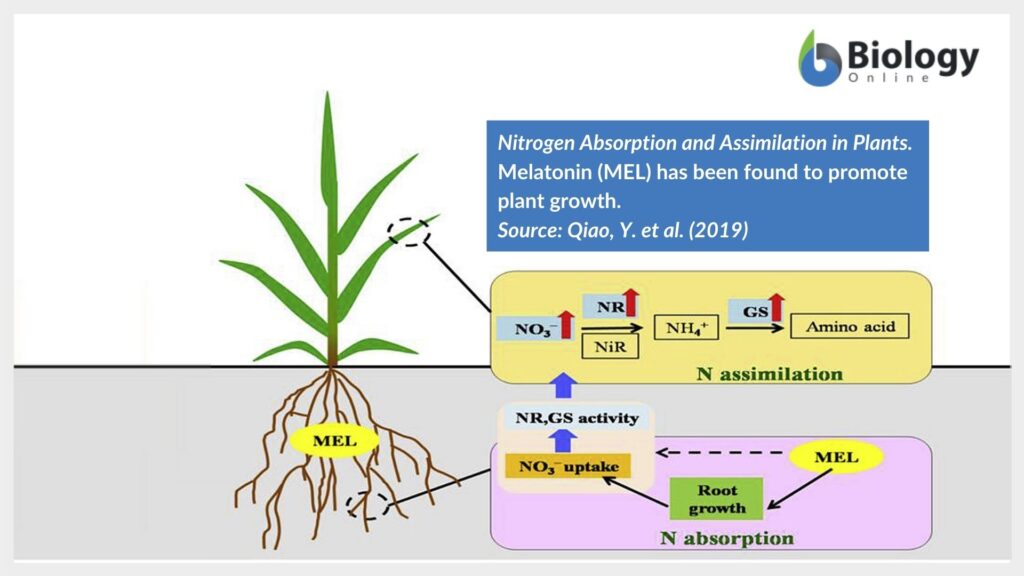
Invertebrate assimilation
Eating and digestion are two of the most important processes in assimilation in invertebrates. Although assimilation is a very easy process in some invertebrates in many, it is referred to as a tedious procedure. The nutrients are absorbed straight away from the host digestive system by tapeworms. The sponges and corals directly take the food particles through a process called phagocytosis. There is a single, long digestive tract extending from mouth to anus in nematodes. Hence, it can be concluded that all forms of invertebrates take energy from the nutrients in one way or another, they all employ assimilated nutrients for growth and energy [4].
Human digestion – assimilation
The digestive system of humans is relatively complex as compared to plants and insects to assimilate food and water. Food injected in the mouth travels all the way to the stomach where the process of digestion starts. The infectious bacteria are killed by hydrochloric acid and the larger food particles are converted and assimilated into smaller ones that are transported into cells. The food after the stomach is pushed into the small intestine, where it is mixed with liver bile and pancreatic juices. The nourishment is digested properly and then the nutrients in the food are supplied to various cells in the body where the energy is required. Later after the distribution of nutrients, the remaining mesh is forwarded to the large intestine. Hence, it can be concluded that the process of assimilation in human bodies occurs in the small intestine.
Assimilation of Nutrients
The food we eat is assimilated by the cells of our body. The process entails the breaking down of food into simpler particles, digesting it, and then distributing it to the different parts of our body. Moreover, as described earlier, assimilation takes down the nutrients from the food to cells where it is used for growth and reproduction. To understand the concept of assimilation of nutrients, it is very vital to go through the cycle of food digestion.
The digestive system primarily starts from the mouth where the food is chewed. The saliva produced by the salivary glands moistens the food and thus it is passed to the stomach via the esophagus. The starches are also broken down into simpler particles by saliva. As the food enters the stomach, very strong acids and enzymes break the food further into various nutrients such as carbohydrates, proteins, and fatty acids. Hence, the digestion of food is partially complete and then it is pushed into the small intestine where the assimilation of nutrients occurs. For instance, the complete cycle of digestion of food is illustrated in Figure 3.
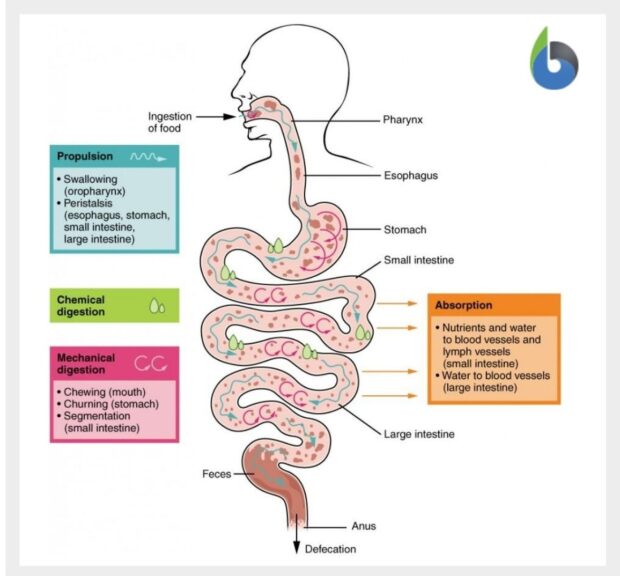
Much of the digestion occurs in the small intestine and its primary task is the absorption and assimilation of the nutrients present in the food. In adults, the average length of the small intestine is around 7 meters.
The small intestine has been further divided into three segments: duodenum, jejunum, and ileum as shown in Figure 4, which are covered by the omentum anteriorly [6].
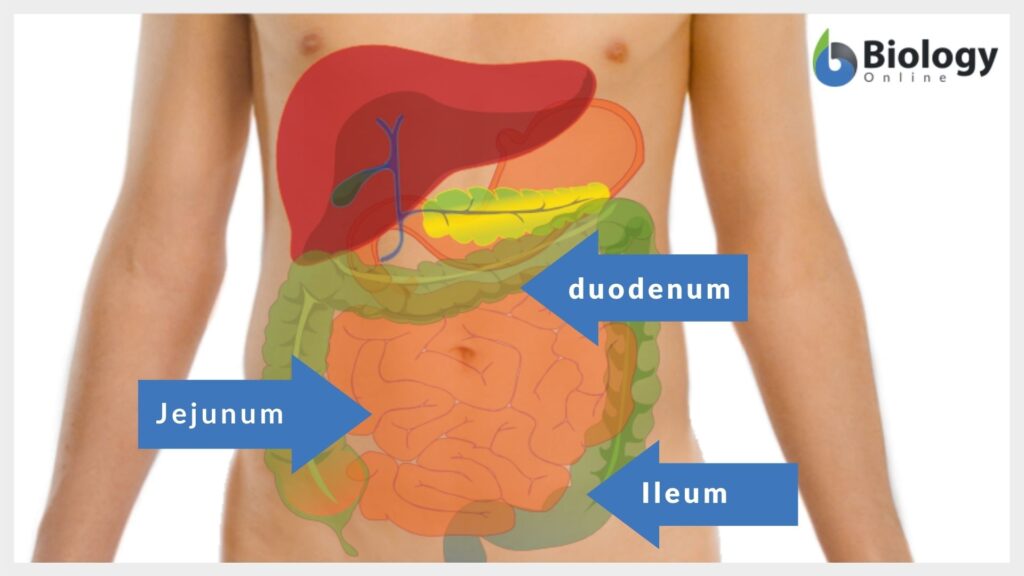
The duodenum is divided into four parts that are inferior, superior, ascending, and descending altogether around 25 cm long. The fats available in the food are often digested by bile salts from the liver. The carbohydrates and fats are digested via pancreatic enzymes. The acid that arrives with the food from the stomach is neutralized by bicarbonate from the pancreas.
The proper digestion of food and its conversion into nutrients are associated with the healthy working of the liver and pancreas. After the proper digestion of the chyme in the duodenum, it is passed to the jejunum, and around 90% of the assimilation of nutrients including protein, carbohydrates, vitamins, and minerals is achieved here.
The small intestine has many minute projections referred to as microvilli. They are used to increase the intestinal cell absorption of nutrients. Then, from the jejunum, the digested nutrients are released into the bloodstream so that other cells can be nourished as well.
Lastly, the absorption of water, bile salts, and some excessive vitamins is completed in the ileum, after which the extra food particles are moved into the large intestine or colon [8].
Malabsorption and Assimilation
The major role of the small intestine in the digestion process is to absorb the nutrients from the food that is eaten and to deliver them to the cells via the bloodstream. There may be a variety of syndromes due to which the smooth working of the bowl is in effect. Hence, those diseases are called malabsorption syndromes. In malabsorption disorders, the intestine is unable to absorb and assimilate both micronutrients (minerals and vitamins) and macronutrients (fats, carbohydrates, and proteins). Damage in the intestine, excessive use of medicines, lactose deficiency, peracetic diseases, radiation therapy, and injured intestine lining are some of the factors that cause malabsorption syndrome. Doctors believe that the said disorder can be predicted via stool, blood, breath, imaging tests, and biopsy. Moreover, malabsorption disorder can be treated by altering the diet, taking vitamin and enzyme supplements, and avoiding dairy products. It is believed that the adsorption of nutrients is badly affected in the human body due to malabsorption syndrome [9].
Factors Affecting Assimilation
Many factors affect the assimilation of nutrients. Some of the key factors that have been dedicated by the doctors that affect the assimilation of organic matter are temperature, the composition of the food intake, the time gap between two meals, the age of culture, and the change in cell concentration and structure. On the other hand, the researchers believe that the human body behaves differently in the assimilation process truly based on the kind of food taken. Moreover, it has also been published in various research articles that daily consumption of green tea and occasional fasting improves the digestion system which results in an advanced assimilation process.
Conclusion
It can be concluded from the above discussion that the distribution of nutrients to various cells is mandatory for their growth, health, and reproduction. The dispersal of nutrients to required destinations from the small intestine is accomplished by assimilation. It is believed that the said process is generally found in both autotrophic organisms and heterotrophic organisms. Moreover, in the small intestine, the complete digestion process occurs in the duodenum, followed by 90% of the assimilation of nutrients including protein, carbohydrates, vitamins, and minerals is achieved in the jejunum. Later, the absorption of water, bile salts, and some excessive vitamins is completed in the ileum. It is believed that the process of assimilation is affected by various factors including the quantity and composition of the food eaten, the time gap between two meals, the age of culture, and the change in cell concentration and structure. Moreover, the smooth execution of assimilation is severely disturbed by malabsorption syndromes, a disorder that occurs due to malfunctioning of the small intestine due to damage in the intestine, excessive use of medicines, lactose deficiency, peracetic diseases, radiation therapy, and injured intestine lining.
READ: Assimilation in Plants – Biology Tutorial
Try to answer the quiz below to check what you have learned so far about assimilation (biology).
References
1. Modes of Nutrition, Heterotrophic & Autotrophic, from: https://socratic.org/questions/what-kingdoms-include-organisms-that-are-autotrophic-or-heterotrophic.
2. Feng Huimin, Xiaorong Fan, Anthony J Miller, and Guohua Xu Journal of Experimental Botany, Plant nitrogen uptake and assimilation: regulation of cellular pH homeostasis. 2020.
3. Qiao Yujie, Lina Yin, Bomei Wang, Qingbo Ke, Xiping Deng, Shiwen Wang Plant Physiology, and Biochemistry, Melatonin promotes plant growth by increasing nitrogen uptake and assimilation under nitrogen deficient condition in winter wheat. 2019. 139: p. 342-349
4. Siders Adam C, Zacchaeus G Compson, Bruce A Hungate, Paul Dijkstra, George W Koch, and Jane C Marks Ecosystems, The Influence of Leaf Type on Carbon and Nitrogen Assimilation by Aquatic Invertebrate Communities: A New Perspective on Trophic Efficiency. 2020: p. 1-18.
5. Digestive System Processes and Regulation. Anatomy and Physiology II, from: https://courses.lumenlearning.com/ap2/chapter/digestive-system-processes-and-regulation/
6. Pavić Mirela, Marcela Šperanda, Hrvoje Brzica, Suzana Milnković-Tur, Manuela Grčević, Ivana Prakatur, Ivona Žura Žaja, and Marija Ljubojević, Veterinarska Stanica Transepithelial glucose transport in the small intestine. 2020. 51(6): p. 0-0.
7. Physiology and Pathophysiology of the Human Body. From: https://sites.google.com/site/pathofizz/digestive-system
8. Salva Mn, Chandni Gupta, Arvind Kumar Pandey, Nitesh Kumar, Sushma R Kotian, and Sneha G Kalthur Ethiopian Journal of Health Sciences, Histogenesis and histomorphometric study of human fetal small intestine. 2019. 29(6).
9. Schiller Lawrence Current Gastroenterology Reports, Maldigestion Versus Malabsorption in the Elderly. 2020. 22(7): p. 33-33.
©BiologyOnline.com. Content provided and moderated by BiologyOnline Editors.


